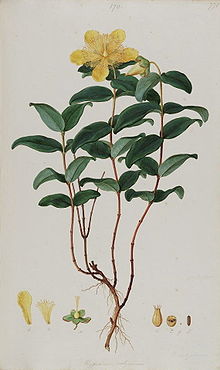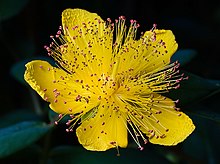
Hypericum perforatum, commonly known as St John's wort, is a flowering plant in the family Hypericaceae. It is a perennial plant that grows up to one meter tall, with many yellow flowers that have clearly visible black glands around their edges, long stamens, and three pistils. Probably a hybrid between the closely related H. attenuatum and H. maculatum that originated in Siberia, the species is now found worldwide. It is native to temperate regions across Eurasia and North Africa, and has been introduced to East Asia, Australia, New Zealand, and parts of North and South America. In many areas where it is not native, H. perforatum is considered a noxious weed. It densely covers open areas to the exclusion of native plants, and is poor grazing material. As such, methods for biocontrol have been introduced in an attempt to slow or reverse the spread of the species.

Hypericum is a genus of flowering plants in the family Hypericaceae. The genus has a nearly worldwide distribution, missing only from tropical lowlands, deserts and polar regions. Many Hypericum species are regarded as invasive species and noxious weeds. All members of the genus may be referred to as St. John's wort, and some are known as goatweed. The white or pink flowered marsh St. John's worts of North America and eastern Asia are generally accepted as belonging to the separate genus TriadenumRaf.

Hyperforin is a phytochemical produced by some of the members of the plant genus Hypericum, notably Hypericum perforatum. Hyperforin may be involved in the pharmacological effects of St. John's wort, specifically in its antidepressant effects.
Arachidonate 5-lipoxygenase inhibitors are compounds that slow or stop the action of the arachidonate 5-lipoxygenase enzyme, which is responsible for the production of inflammatory leukotrienes. The overproduction of leukotrienes is a major cause of inflammation in asthma, allergic rhinitis, and osteoarthritis.

Hypericum maculatum, commonly known as imperforate St John's-wort, or spotted St. Johnswort, is a species of perennial herbaceous flowering plant in the family Hypericaceae. It is native to Europe and Western Asia where it grows in moist meadows.

Hypericum androsaemum, the shrubby St. John's wort, is a flowering plant in the family Hypericaceae. Commonly called tutsan or sweet-amber, the species is cultivated as an ornamental plant because of its striking red-tinted foliage, bright yellow petals, and its large clusters of fruit. Cultivars like 'Albury Purple' and 'Golden Tutsan' which have leaves with more pronounced purple and golden coloring, respectively.

Adhyperforin is a phytochemical found in the members of the plant genus Hypericum including St. John's Wort. It has a very similar pharmacological profile to hyperforin and acts as a TRPC6 ion channel activator, thereby inhibiting the reuptake of various neurotransmitters including serotonin, norepinephrine, dopamine, GABA, and glutamate. Adhyperforin is found in St. John's Wort in levels approximately 1/10 those of hyperforin.
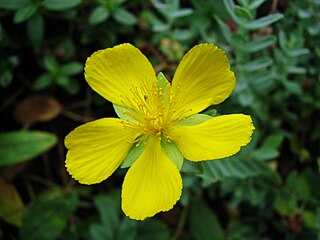
Hypericum olympicum, commonly known as the Mount Olympus St. John's wort, is a species of flowering plant in the family Hypericaceae found in the Balkans and Turkey and introduced to western Europe. It has been widely cultivated for centuries because of its large, showy flowers, which are far larger than those of most other species in Hypericum.
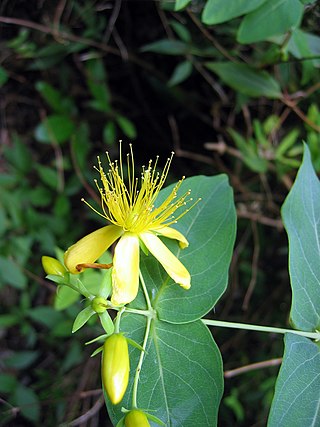
Hypericum grandifolium, the large-leaved St John's wort, is a species of flowering plant in the family Hypericaceae. The plant is a bushy shrub that can grow to almost 2 meters tall. It has large leaves, golden yellow petals, and seed capsules that split open. H. grandifolium is native to the Canary Islands and Madeira in Macaronesia, but has become invasive in other regions, including California, after escaping from cultivation as an ornamental plant. It is parasitized by wasps and fungi, and is capable of reproducing through its rhizomes.

Hypericum hirsutum is a species of flowering plant in the family Hypericaceae, commonly known as hairy St John's-wort. It is found in Western Europe.

Hypericum ericoides is a dwarf shrub in the flowering plant family Hypericaceae, section Coridium. It is found in eastern and southeastern Spain, Morocco, and Tunisia. Its preferred habitat is fissures in calcareous rocks in warm, sunny places, from 200 to 2,000 meters above sea level (MASL).

Hypericum aegypticum is a species of flowering plant of the St. John's wort family (Hypericaceae) which is native to the Eastern Mediterranean. It was described by Carl Linnaeus in the second volume of his Species Plantarum in 1753, who named it after Egypt despite it not being distributed there. The plant is commonly known as shrubby St. John's wort or Egyptian St. John's wort in English. Like other members of section Adenotrias, it is found among limestone rocks in coastal areas. While it has been evaluated as threatened on the island of Malta, the species has no legal protections.

Hypericum bupleuroides is a species of perennial flowering plant in the St John's wort family, Hypericaceae. It grows 45–80 centimeters tall, and notably has perfoliate leaves that are fused at the stem. It has pyramid-shaped flower clusters of 1 to 25 flowers with yellow petals in a star-shaped arrangement. The species is found along the Black Sea coast near the Turkish–Georgian border. Hypericum bupleuroides has a small distribution and specific habitat requirements that make it vulnerable to environmental pressures.
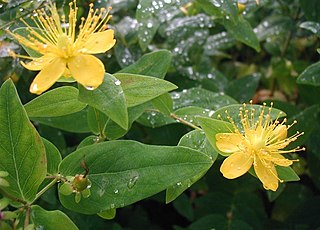
Hypericum hircinum is a species of perennial flowering plant in the St John's wort family, Hypericaceae. It is known as goat St John's wort and stinking tutsan; both names refer to the plant's distinctive odor. The species is a bushy shrub that can grow up to 1.5 meters tall, is many-stemmed, and has golden yellow flowers with conspicuous stamens. The plant has been well-documented in botanical literature, with mentions dating back to at least 1627. Carl Linnaeus described H. hircinum several times, including in his 1753 Species Plantarum which established its binomial. At one point the plant was placed into the defunct genus Androsaemum, but it was returned to Hypericum by Norman Robson in 1985.

Hypericum foliosum, the shining St John's wort, is a species of flowering plant in the family Hypericaceae. It is a bushy shrub endemic to the Portuguese Azores Islands with golden yellow petals and many stems. The species was described by William Aiton in 1789 and was later placed into section Androsaemum of the genus Hypericum by Norman Robson in 1984. It has a diverse essential oil profile made up mostly of monoterpene hydrocarbons, and significant concentrations of various medicinally useful phenols and carotenoids. Populations of the plant are small in number, but quick to colonize cleared areas like groves, landslide areas, and volcanic ash deposits. It is parasitized by fungus and by moth species, but is not considered endangered by the IUCN. H. foliosum is used in traditional medicine on the Azores for diuretic, hepatoprotective, and antihypertensive purposes. It also has in vitro antibiotic and antioxidizing capabilities.
Hypericum edisonianum, known as Arcadian St. John's wort, Edison's St. John's wort, and Edison ascyrum, is a species of flowering plant in the St. John's wort family, Hypericaceae. It is endemic to Florida.

Hypericum lancasteri, known as Lancaster's St. John's wort or as zhan e jin si tao in Chinese, is a species of flowering plant in the St. John's wort family Hypericaceae. The species has been awarded the Royal Horticultural Society's Award of Garden Merit.
Hypericum myrtifolium, the myrtleleaf St. Johnswort, is a species of flowering plant in the St. John's wort family, Hypericaceae. It is endemic to the Southeastern United States. It was first described by Jean-Baptiste Lamarck in 1797.
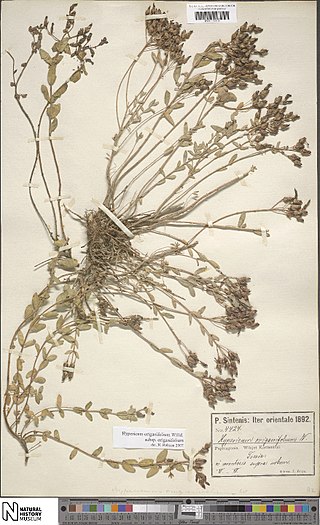
Hypericum origanifolium is a species of flowering plant in the family Hypericaceae. It is native to Turkey, the Caucasus, and northwestern Syria. The species can be found in dry, often rocky, soil and on cliff slopes and ledges.
